The (dreaded) snatch test. Five minutes (of suck) that many StrongFirst instructors consider the most stressful in their certifying or recertifying process. But you can set yourself up for success with an excellent preparation program, provided you dial in your technique first and understand some common pitfalls that derail potentially successful attempts. In this article, Khalil El Mallah presents two common snatch test dangers—peaking heart rates and rushing—and shares his plan that beats both.
The StrongFirst snatch test is a well-known and often feared part of the requirements to pass the SFG I Kettlebell Instructor Certification. The premise is simple: snatch a kettlebell overhead 100 times in under five minutes while adhering to the SFG technique standard. The size of the kettlebell is determined by your gender and bodyweight.
At my previous 97kg, snatch testing with a 24kg kettlebell was challenging but achievable. Now, at over 100kg, the standard requires a 28kg kettlebell. This definitely challenges my weak points: as an asthmatic, I have to rely more on my strength than my lung capacity.
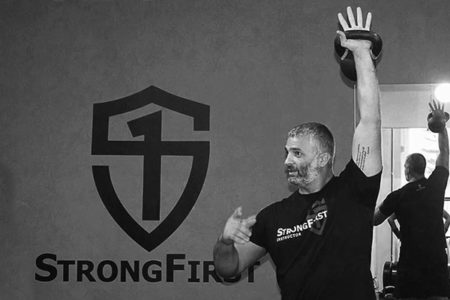
After several failed attempts while training in my gym, and seeing many others also come up short, I stepped back into my coaching shoes to analyze: What were the most challenging points? And, what focused adjustments could help us ace the snatch test?
Weak Point 1: Peaking Heart Rate
Experience shows that most of us—especially when using a challenging bell size—start to struggle around three minutes into the test. This is normal because it takes three minutes for the heart rate (HR) to peak and then the body’s systems (cardiovascular, hip power, overall strength and endurance) diminish, as explained in the Strong Endurance™ Manual:
“As the HR increases in exercises, the stroke volume grows with it, up to a point. But once the HR exceeds 170-180, the duration of the diastole becomes too short for ATP to fully resynthesize between beats and the cardiac contractions’ strength diminishes. This leads to a reduction in the stroke volume.”
(Holmgren, 1956: Holmgren & Ovenfors, 1960)
In practical terms, this means that less blood—and less oxygen—gets pumped to your working muscles regardless of how much you are sucking wind.
“It explains why your performance starts dropping if you train at a heart rate above 180 beats per minute. So the objective is to be able to perform more work at a lower HR cost,” clarifies Master StrongFirst Certified Instructor, Shaun Cairns.
Weak Point 2: Rushing Through
Although the test must be completed within five minutes, adrenaline, fear, and a competitive spirit combine into a powerful drive towards finishing the test (or, depending on your mindset, just getting it over with) as soon as possible. Unfortunately, this often backfires when you get tantalizingly close to the 100th rep.
On four separate certifications in my gym, attendees lost their bell at repetitions 95 and above, despite having 20 to 40 seconds left on the clock. They would all have benefitted from pacing themselves, taking advantage of the full five minutes available.
No one gets a gold star for finishing early. It’s pass or fail. Period.
Personalizing Your Snatch Test Strategy: Start with Simple
Now, there are many ways to approach a snatch test—from snatching at a set pace, taking set breaks or not, asymmetrically loading a stronger arm, to any number of creative variations. What works for a “strength” person may not work for an “endurance” one and vice versa.
My suggestion is to start out simple, without over-complicating the math or overthinking the task. Five sets of 10/10 (usually on the minute), so that you change hands before exhausting the power of the working arm. While the other arm works, the first one rests and recovers. Repeat until done.
However, given the two common weak points that I outlined above, I suggest a subtle yet profound tweak to the usual “on the minute” count. Not only does it control your pace so you don’t rush, but it also keeps your heart rate from peaking for as long as possible. I’ve had great success personally and with my students with the following protocol.
The 55-Second Interval Plan
There are two ideas behind the 55-second interval. The first is to set the kettlebell down to recover after each 10/10 set. Mind you, this is not the time to take a walk, drink your coconut water or whatever. It’s a time to quickly de-ramp your stress sufficiently so that your next set will be as good as the previous one. The second idea is to “steal” five seconds from each of the first four working minutes to give yourself an extra 20 seconds of rest at the end of your fourth set. This means that after completing your fourth set of 10/10, and with 80 reps done, instead of resting for 20 seconds—which is what you would have had by starting each set on the minute—you get a welcomed 40 seconds of rest just when your heart rate is peaking and when you need it most.
Note that this assumes an approximate snatch test cadence of 20 reps per 35 seconds (including one hand switch). At no time should you sacrifice your motionless lockout for speed; just don’t luxuriate in it.
The Training Plan
- Use a bell one size heavier than your test size, or two sizes heavier if not challenging enough.
- Train both heavy snatches and one-arm swings once a week (each) using the same protocol.

Here is a training plan to build your endurance towards snatching 10/10 every 55-seconds for four rounds, then finishing the last 10/10 at 4:20.
In this example, we start with 6 reps per arm and move up by 2 reps per session.
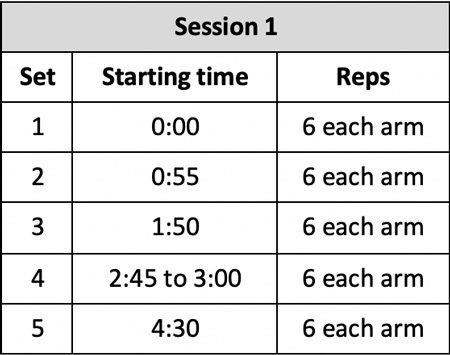
The working time for 6 reps each side will be around 27 seconds, leaving approximately 28 seconds of rest. The total number of reps is 60.
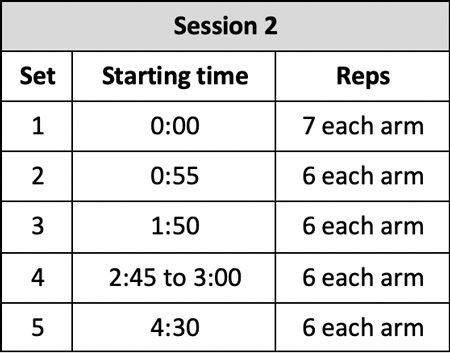
The working time for 7 reps each side will be around 31 seconds, leaving approximately 24 seconds of rest. The total number of reps is 62.
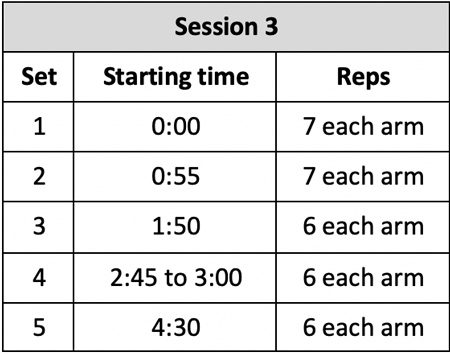
The total number of reps is 64.
And so it continues; in every session, we add 2 reps until we reach 8,8,8,8,8. Following the same progression as presented, we would get there on session 11.
Note: This plan isn’t necessarily linear. We repeat the same session until we can complete it comfortably.
When we reach that last training session—8 reps on each arm using a ‘heavier than snatch test’ kettlebell—we start our fifth set at 4:20 to ensure we finish in just under five minutes. We get forty seconds for the last 20 repetitions.
At this point, you are ready to “test” using your snatch-sized bell—four rounds of 10/10 every 55 seconds, then your last set starting at 4:20. Sure you could have pushed for a few extra training sessions chasing 9/9, maybe even hitting 10/10 with the heavier weight. But this plan is about setting yourself up for success in a sustainable way. Being able to smash your snatch test with a weight one or two sizes heavier than required isn’t the objective.
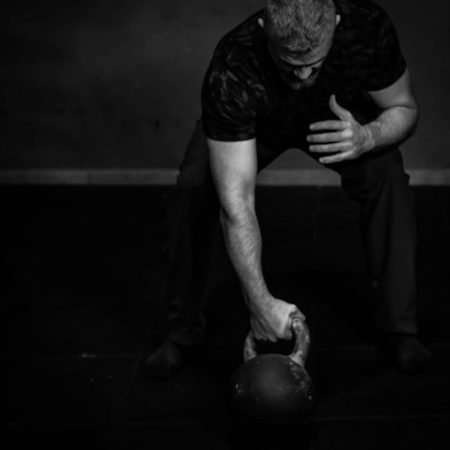
Program Options
Keep in mind that the starting number of reps and the number of reps added on each session can vary based on the individual’s abilities. For example:
- To make it easier, we can start session 1 with 5 reps on each side;
- To make it harder, we could move up by 4 reps each session, which would mean: 5,5,5,5,5 then 6,6,5,5,5 then 6,6,6,6,5 then 7,6,6,6,6 etc. If it starts to feel heavy, then we can revert to adding only 2 reps each time.
Your heavy one-arm swing practice using the same scheme—both once a week—will be extremely helpful in developing hip power and grip.
Snatch Test
By the time we have finished the final session and are able to perform 80 reps in five minutes with a heavier bell (8/8 x 5), 100 reps with the test size bell should feel relatively easy. Our body will be used to taking the full five minutes and the test bell size will feel light. We will have more hip hinge strength, explosiveness, and power, so we depend less on our cardiovascular system. We will have successfully eliminated those common weak points and overcome the challenges of the snatch test with ease. Your competitive drive will remain. So will some adrenaline. But the fear will be greatly diminished.
Therefore, if you are preparing for your first snatch test or getting ready to recertify—yes, you still need to pass the snatch test to achieve the StrongFirst Certified Elite Instructor designation (all four SFG, SFGII, SFB, SFL)—give this 55-second interval plan a try. Let us know from where you started and how it went by commenting below or in our online community forum.



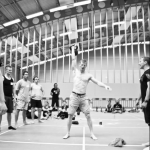

Amazing stuff coach… thanks for the advice and program… I will try this out and get back to you and I’ll be sure not to take a break and a coconut water between sets 😉
Achieved my first snatch test using this scheme. Went great!
good to know.
hey Sam, sorry for the late reply, ill be waiting for the feedback.
Question on this program, is session 1 considered week 1 so on and so forth, or are we to do all sessions in one day, once a week?
Hello, yes session one is considered week 1. I would advise first training day in the week you do S.A Swing heavy (32,36,…) same program protocol then after 2 to 3 days you do the snatch session.
Simply said: I owe passing my SFG1 snatch test to Khalil’s training plan.
I went from zero to “hero” in 3 weeks.
Khalil, great article. I love it!
My friend sasa, long time hope we meet soon.
This is really cool. I got close with 24kg twice, the second time using a training and test method similar to this. I’ll give this format a try!
Brilliant article. I absolutely love the KB snatch. I’ve been using kettlebell for about 18 months and had reached simple standard with swings and get ups. I have started serious snatch programs in the past but always have to stop as my hands get torn up……any advice on that. I have no hand issues with swings or cleans just seems to be the snatch. Feel it’s as the bell is dropping down fro above head is were my issues maybe caused.
Hello Carlo, many reasons could cause this injury.
You could loosen your grip because tight grip on the bell will cause rubbing the bell handle on your skin, so you have to throw the bell from your palm to your fingers and vise versa.
It could be because you are using too much chaulk or not enough.
Hope this helps.